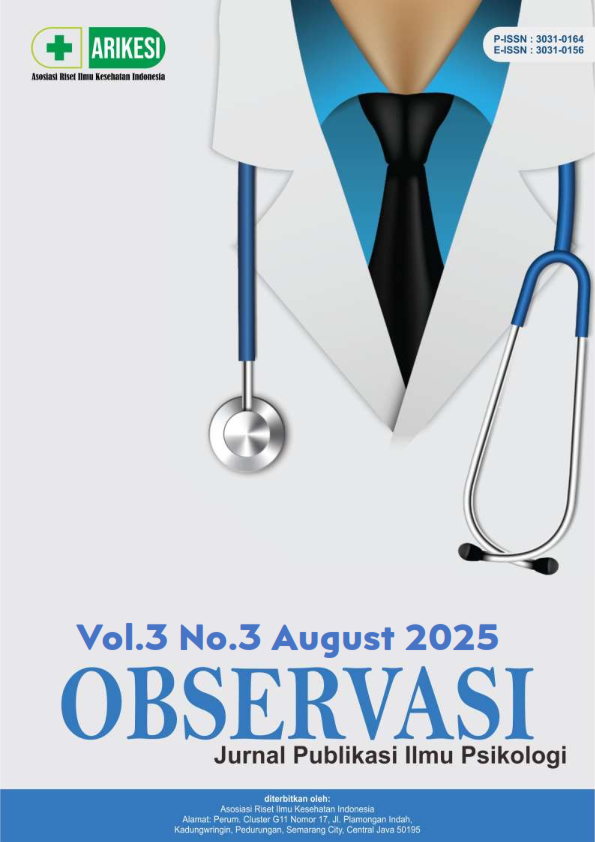Psikoedukasi “SOBER X Teen” dalam Mengontrol Perilaku Cybersex pada Siswa SMP
DOI:
https://doi.org/10.61132/observasi.v3i3.1369Keywords:
Cybersex, Psychoeducation, SOBER X TeenAbstract
This research aims to determine the effect of SOBER X Teen psychoeducation in controlling cybersex behavior among adolescents The research design is a one group pretest and posttest design The subjects consisted of 68 8th grade junior high school students aged 13-15 years, both male and female The measurement tool used was the cybersex scale Data analysis was conducted using paired sample t-test to observe the differences in cybersex behavior before and after receiving psychoeducation The research results indicate that the p-value = 0000, which is less than 005, meaning that there is an influence of SOBER X Teen psychoeducation on adolescents' understanding of cybersex The implication of this study is that SOBER X Teen psychoeducation can be used as a method to control cybersex behavior in adolescents.
Downloads
References
Aiyuda, N. (2020). Kontrol diri terhadap cybersex pada remaja. Psychopolytan: Jurnal Psikologi, 3(2). https://doi.org/10.36341/psi.v3i2.966
APJII. (2024). Profil Internet Indonesia 2024. Asosiasi Penyelenggara Jasa Internet Indonesia.
Cooper, A. (Ed.). (2002). Sex and the Internet: A guide book for clinicians (1st ed.). Routledge. https://doi.org/10.4324/9780203890349
Cooper, A., Delmonico, D., Griffinshelley, E., & Mathy, R. (2004). Online sexual activity: An examination of potentially problematic behaviors. Brunner-Routledge; Taylor & Francis Health Science. https://doi.org/10.1080/10720160490882642
Delmonico, D. L., & Miller, J. A. (2003). The internet sex screening test: A comparison of sexual compulsives versus non-sexual compulsives. Sexual and Relationship Therapy, 18(3), 261–277.
Diananda, A. (2018). Psikologi remaja dan permasalahannya. Istighna, 1(1).
Hapsari, A., & Ariana, A. D. (2015). Hubungan antara kesepian dan kecenderungan kecanduan internet pada remaja. Jurnal Psikologi Klinis dan Kesehatan Mental, 164–171.
Imawati, D., & Sari, M. T. (2018). Studi kasus kecanduan pornografi pada remaja. Motiva: Jurnal Psikologi, 1(2). http://ejurnal.untagsmd.ac.id/index.php/MV/article/view/4132/3989
Judita, C. (2020). Perilaku cybersex pada generasi milenial. Jurnal Pekommas, 5(1). https://doi.org/10.30818/jpkm.2020.2050106
KOMINFO. (2021). Dinamika data aplikasi informatika 2021. Kementerian Komunikasi dan Informatika.
Noorca, D. (2021). Lebih dari 60 anak mengakses konten pornografi melalui media online. Suara Surabaya. https://www.suarasurabaya.net
Nursal, D. G. A., Hasanah, S. N., Afrila, G., Mutia, M., Nasitoh, S., & Baretta, M. S. (2024). Menuju generasi digital sadar: Upaya meningkatkan pengetahuan dan sikap tentang cybersex di kalangan remaja. Warta Pengabdian Andalas, 31(1), 116–127.
Priyanggi, A. (2018). Hubungan antara interaksi teman sebaya dengan perilaku cybersex pada remaja [Skripsi, Universitas Medan Area].
Putri, M. D., Ananda, A., & Syahputra, H. (2023). Pengaplikasian uji T dalam penelitian eksperimen. Jurnal Ilmiah Pendidikan Matematika, Matematika dan Statistika, 4(3). https://doi.org/10.46306/lb.v4i3.527
Safitri, C. A., & Wicaksana, B. S. (2020). Psikoedukasi perilaku seksual remaja. Altruis.
Santrock, J. W. (2002). Adolescence: Perkembangan remaja (Edisi keenam). Erlangga.
Seniati, L., Yulianto, A., & Setiadi, B. N. (2005). Psikologi eksperimen. Indeks.
Sugiyono. (2013). Metode penelitian kuantitatif, kualitatif, dan R&D. Alfabeta.
Wery, A., & Billieux, J. (2015). Problematic cybersex: Conceptualization, assessment, and treatment. Addictive Behaviors. https://doi.org/10.1016/j.addbeh.2015.11.007
Yudistira, C., & Cahyoriniatri, N. (2022). Modul pendidikan seks pada remaja. Nas Media Pustaka.
Downloads
Published
How to Cite
Issue
Section
License
Copyright (c) 2025 Observasi : Jurnal Publikasi Ilmu Psikologi

This work is licensed under a Creative Commons Attribution-ShareAlike 4.0 International License.





